In its second annual Wage and Morale Survey, Lighthouse Lab Services found improvements in wages and satisfaction, but the industry could still do more to alleviate dissatisfaction and improve retention.
By Alex Mitchell
For medical laboratories, attracting and retaining top talent is essential for providing quality patient care and maintaining efficient operations. However, employee turnover, especially due to retirements and the aging workforce, has become one of the most significant hurdles labs are facing as the industry works to bolster the overall recruitment pipeline. With that in mind, it is crucial for lab leaders to implement innovative strategies that show a true investment in their employees to foster a loyal and engaged workforce.
To help shine a light on these ongoing issues, Lighthouse Lab Services recently conducted its second annual wage and morale survey of medical lab professionals. The goal of this initiative, according to Lighthouse President Jon Harol, is to determine correlations between wages, morale, different positions, and experience levels as the medical laboratory industry continues to seek ways to better advocate for more training programs and new talent.
“We learned some good lessons last year when we first conducted this survey and hope to build on those takeaways to better illuminate and improve the status of the medical laboratory industry and professionals who support it,” says Harol. “We’ve noticed that some industry wage studies only survey employees of hospitals and health systems, and that becomes a bit of an echo chamber, which is something we aimed to avoid with this project.”
The results of the 2023 survey show a slight improvement in the overall workplace satisfaction levels of the majority of the 1,062 respondents. However, despite these modest positive gains, most continue to report feeling the workforce strain placed on individuals within the profession despite receiving compensation increases over 2022 wages.
Demographics and Education
In total, Lighthouse Lab Services collected data from 1,062 respondents. Of those, 62% described their race/ethnicity as White or Caucasian, while 14% identified as Black or African American, and 9% as Asian or Pacific Islander. An additional 6% identified as Latino or Hispanic, with Native Americans, multiracial individuals, and those identified as “not listed” comprising the remainder of the population.
This year, we also collected data on the gender of respondents after failing to do so as part of our 2022 survey. Individuals identifying as female comprised the overwhelming majority of our respondents at 74%. Meanwhile, men totaled 24% of responses, while those who identify as non-binary or preferred not to disclose their gender made up the remaining 2%.

Respondents predominantly identified their roles as technologists (49%), followed by managers (20%), technicians (15%), administrative lab directors (7%), lab assistants/accessioners (4%), board certified CLIA lab directors (3%), and administrative support/other (2%). A plurality of individuals (40%) indicated they have 21 or more years of experience as a lab professional, while those with five or fewer years of experience comprised 20% of responses.
The vast majority of respondents (72%) said they work in a high-complexity lab, and 21% described their lab as moderate complexity. Additionally, 2% work in waived-complexity labs, while 6% were unsure of the complexity of their lab.
As for education, most of the individuals who completed the Lighthouse Lab Services survey reported having earned a bachelor’s degree (56%) or master’s (22%). Those holding associate degrees totaled 13% of our responses, while 5% reported having earned a doctorate, and 3% with a high school diploma.
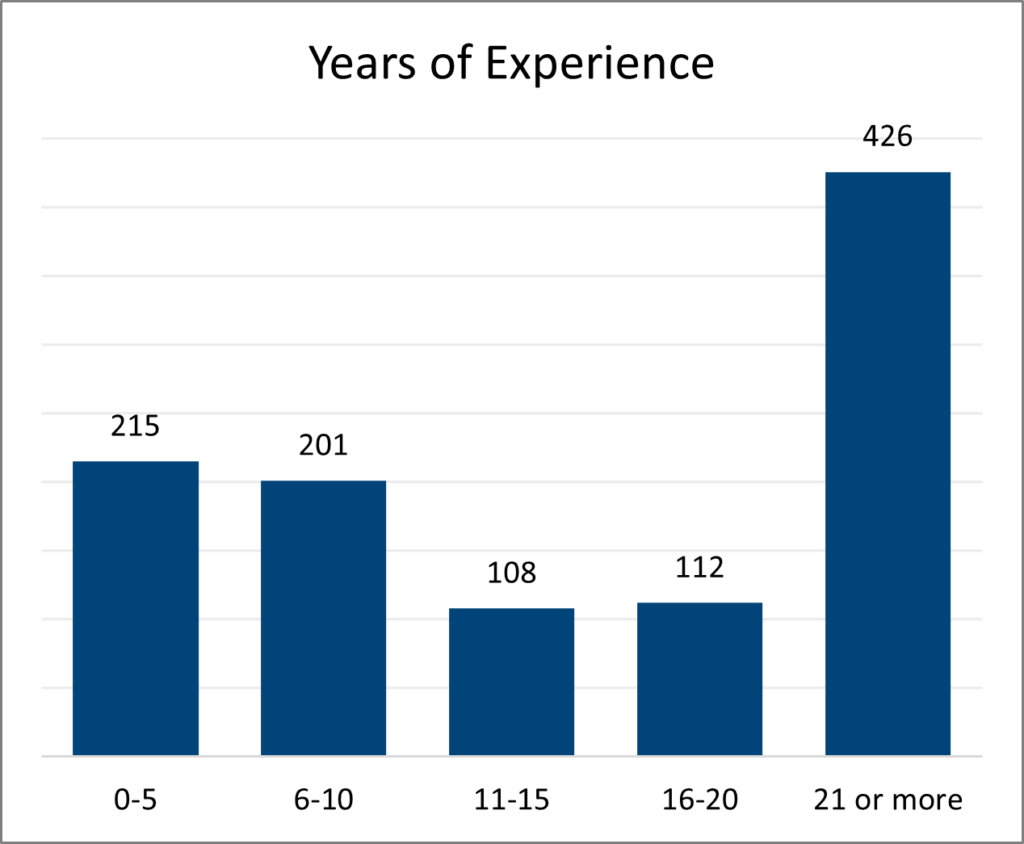
Staffing Levels Continue to Impact Morale
One of the most significant takeaways from our 2022 report was the immense effect low staffing levels have on the morale of individual lab professionals. That impact continues to be felt this year.
According to this year’s results, 41% of respondents indicated their lab is moderately understaffed, while another 26% described their lab as significantly understaffed. This represents a slight improvement from the 73% of respondents who reported feeling significantly or moderately understaffed in 2022. While this result may be impacted by lower sample volumes some labs are experiencing due to the end of the pandemic, we did not specifically inquire about changes to lab test volume impacting morale.
Just 31% of respondents felt their lab is adequately or well-staffed, up slightly from the 27% who reported satisfaction with their staffing levels in 2022. Unsurprisingly, the respondent’s perception of staffing levels had a direct correlation to their feelings of satisfaction, with those perceiving their lab’s staffing situation favorably more likely to express satisfaction with their role.
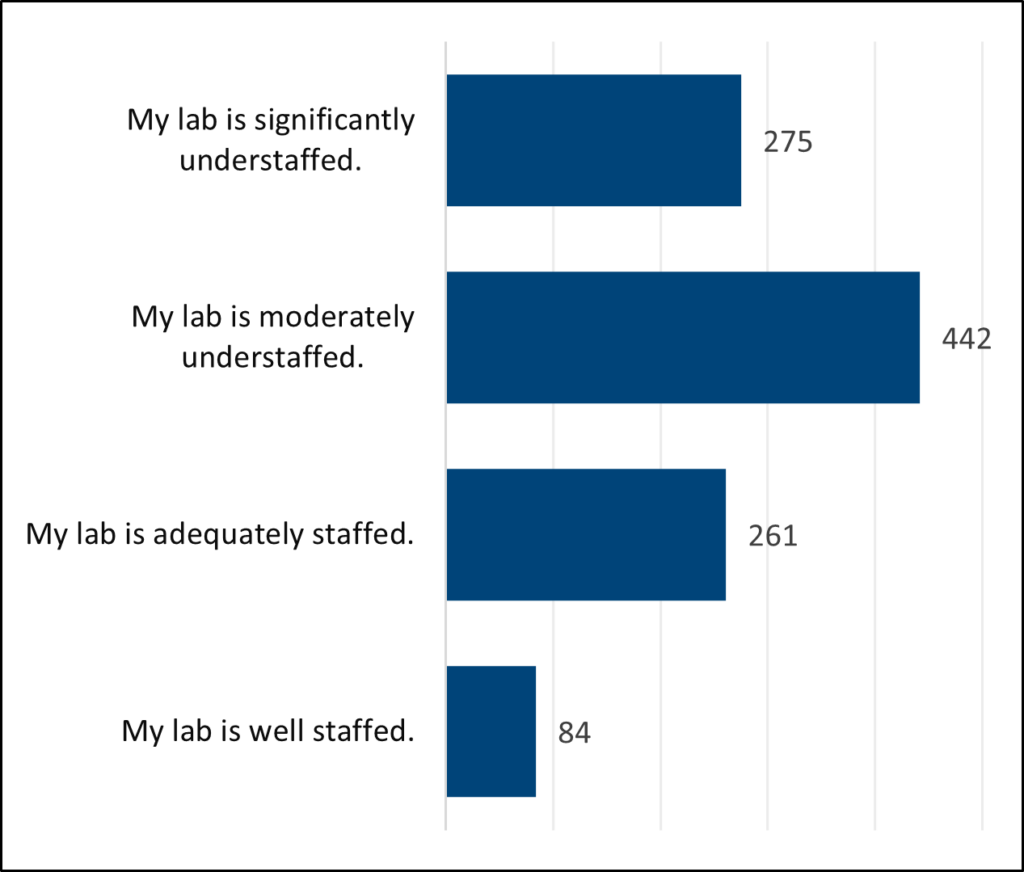
The following graph displays satisfaction levels among the 67% of respondents (717 total) who described their lab as moderately or significantly understaffed. Of this group, 41% described themselves as extremely or moderately unsatisfied in their role, while another 24% stated their morale was neutral. Just 35% of respondents who felt their labs had staffing issues said they were moderately or extremely satisfied with their careers, a slight increase from the 32% of lab professionals with staffing issues who reported satisfaction with their careers in 2022.
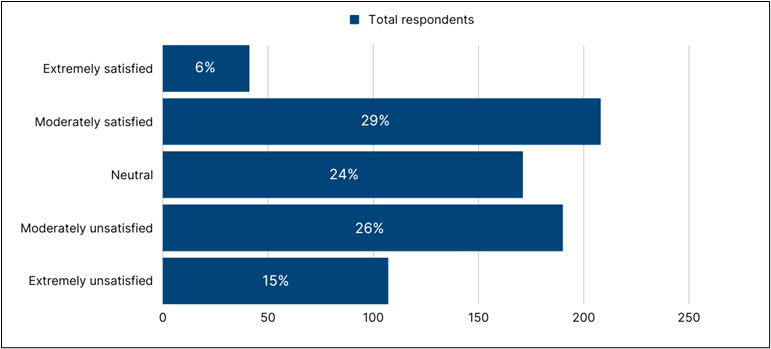
Finally, a majority of respondents (52%) described themselves as “overworked” relative to their position, which makes sense in light of reported staffing shortages. The remainder described their workload as adequate (33%), while just 15% said they were satisfied with their current workload.
Several respondents noted low morale was, in some cases, caused by the shift during COVID that led many labs to persistently rely on temporary or travel employees, resulting in significant turnover and increased workloads for those who chose to stay in permanent positions.
“Often, labs are left understaffed, which forces those permanent staff members that are dedicated to the facility to pick up an abundance of extra hours,” one respondent commented. “This in turn leads to exhaustion that could have a negative impact on quality.”
Wage Averages by Position
The national average reported compensation across all positions was $81,840, collected from 904 respondents who chose to submit wage data. This falls almost exactly in line with our reported average of $81,188 collected from 1,082 respondents across all positions in the 2022 study.
The total pool of respondents for each position breaks down as follows: technologists (443), managers (182), technicians (135), administrative lab directors (67), lab aassistant/accessioner (33), CLIA lab director (28), and administrative support/other (15). Last year, Lighthouse Lab Services elected to break California out as its own carveout due to traditionally higher averages of compensation within the state. However, we have opted not to do so this year after reviewing feedback from respondents who prefer data compiled to represent complete national averages.
The chart below depicts the 2023 national annual compensation by position compared to data collected in 2022. As noted above, most positions remained consistent with very slight changes from last year’s reported figures, with the exception of totals for CLIA lab directors. We primarily attribute this to our increased efforts to filter responses between CLIA and administrative lab directors through additional screening questions.
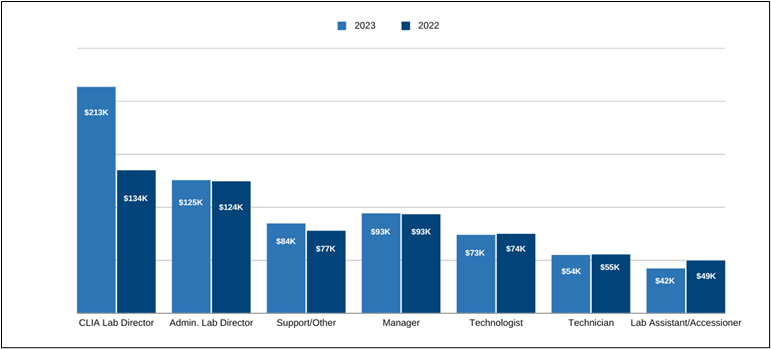
Recent Raises & the Gender Wage Gap
Overall, while the vast majority of respondents (74%) received a raise in the past year—up slightly from 72% who reported raises in 2022—most compensation increases were modest, with 61% saying their pay bump ranged from a 1% to 5% increase over their previous salary. As expected, those who did not receive a pay raise in the past year were the most likely to indicate higher levels of dissatisfaction within their position.
For the first time this year, the Lighthouse Lab Services survey breaks down reported annual compensation averages by position for both males and females. On average, the 216 men who responded to the survey reported earning $93,418, a 19% increase compared to the average compensation of $76,047 reported by the 670 women who responded. The remainder of our respondents indicated they are either non-binary or chose not to report their gender.

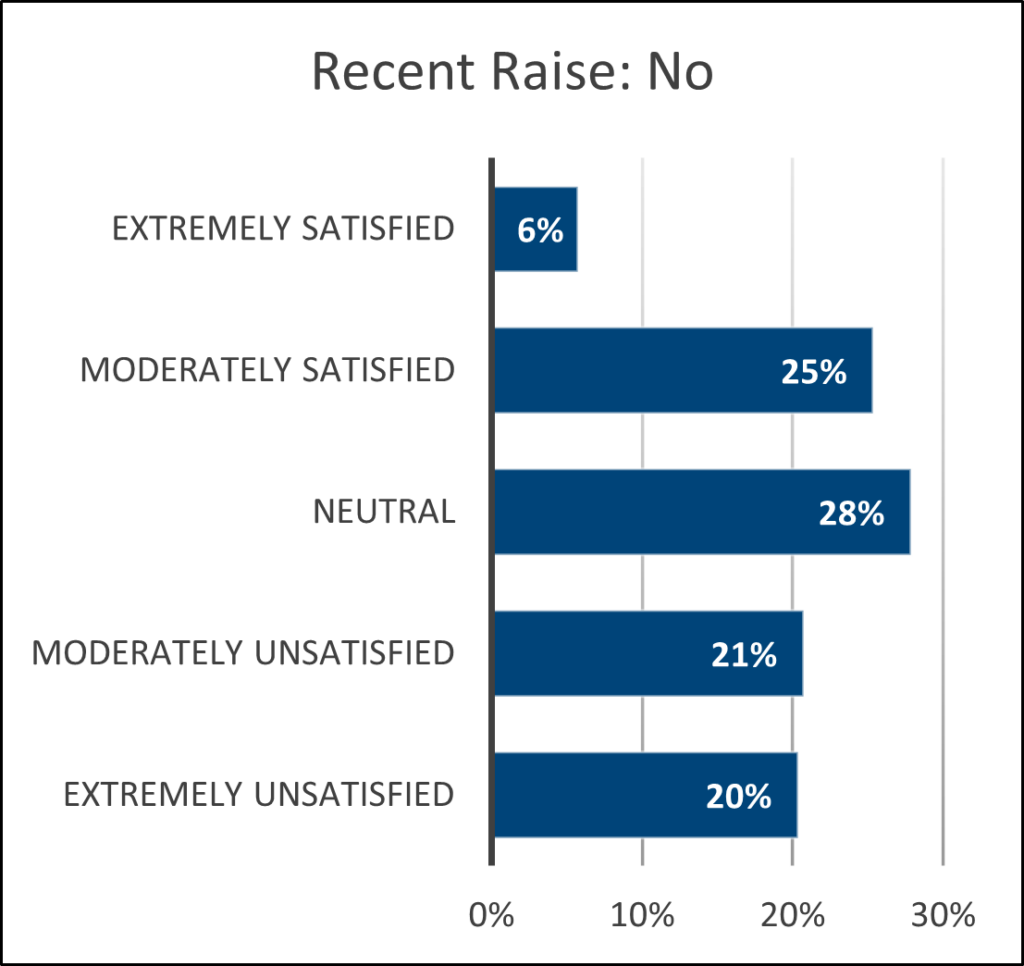
Some respondents noted they did not receive critical care pay increases during the COVID Public Health Emergency while nurses at their facility were awarded increased compensation. Others said their labs continue to lose employees to competitors who are offering better compensation, leading them to wonder why their employers don’t prioritize retention.
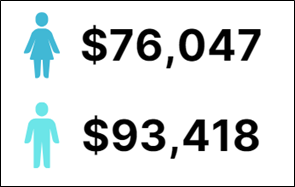
“We have had techs leave for higher-paying jobs for our competitors,” one individual noted. “The techs who remain then feel overworked and underpaid, further reducing morale within the company.”
The charts below break out a few additional details from the Lighthouse Lab Services respondents:
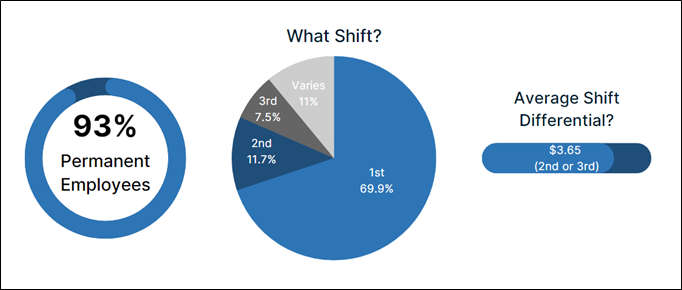
Examining CLIA-Certified Lab Directors
As part of this year’s survey, we took additional efforts to filter responses between CLIA-certified lab directors and their administrative counterparts. This resulted in a more accurate representation of average annual compensation than our reported 2022 amount. In total, we received responses from 34 lab directors who indicated they are CLIA-certified, with 28 electing to submit salary data.
Here is a brief rundown of some of the other data we collected from this group:
- Average salary: $213K
- Average amount made from consulting in 2022: $49K
- 1099 or W-2, if employed by multiple labs?
- 1099 – 43%
- Both – 39%
- W-2 – 13%
- Unsure – 4%
One respondent noted they believe lab directors should be paid above a baseline wage due to the costs and time challenges of pursuing the degrees and certifications required to fill these positions.
“The minimum wage should be at least $100,000 as 90% of post-doctorals have families, and it’s challenging to support a family, even if it’s just one child and spouse,” one respondent commented.
Morale Remains Lower Among Recent Hires
Overall, morale amongst the total pool of respondents increased slightly this year, with 44% saying they are moderately or extremely satisfied in their current role, up from 41% in 2022. Just 32% describe themselves as moderately or extremely unsatisfied, while 23% said they feel neutral about current morale levels.
Last year, we noted lab professionals with five or fewer years of experience were found to be less satisfied than their more experienced peers, with 41% describing being moderately or extremely unsatisfied and another 29% stating they were neutral. Those satisfaction figures improved slightly this year, as just 32% of newer entrants to the field reported some level of dissatisfaction within their role, and another 30% stated their feelings are neutral.
One respondent said they believe salaries for the industry will only be improved by lab professionals and stakeholders working to increase the visibility and public awareness of the profession.
“Right now, this is an underserved and thankless profession that demands notoriety and marketing efforts to improve staffing and wages in the long term,” the respondent commented.
Conversely, those with 21 or more years of experience were found to be the most satisfied with their roles, as nearly 48% described themselves as moderately or extremely satisfied, up from 45% satisfaction reported by this group in 2022. As expected, individuals who reported perceived staffing issues and feelings of being overworked expressed higher levels of dissatisfaction than their peers.

The Industry Must do More
The clinical laboratory industry continues to face an unprecedented staffing crisis that is putting a strain on healthcare systems across the country. This shortage continues to be driven by several factors, including an aging workforce, a lack of training programs, and a significant demand for lab services.
As noted in the introduction, while annual compensation increases have a direct positive impact on the morale of medical laboratory professionals, those increases continue to be modest and appear to have a minimal effect on retention. Beyond just compensation increases, labs can also improve their retention practices through efforts such as creating and discussing clear paths of growth for their employees, investing in uptraining for skilled employees, and regularly engaging them to hear new ideas and areas for improvement.
The industry must also do more to increase recruitment of new individuals to alleviate significant concerns surrounding staffing issues. In addition to recruitment efforts, medical laboratory advocates must also continue to push for an increase in the number of available lab degrees and training programs to increase the staffing pipeline after many of these programs have been shuttered or suffered attrition in recent decades.
ABOUT THE AUTHOR
Alex Mitchell is marketing communications manager at Lighthouse Lab Services.





